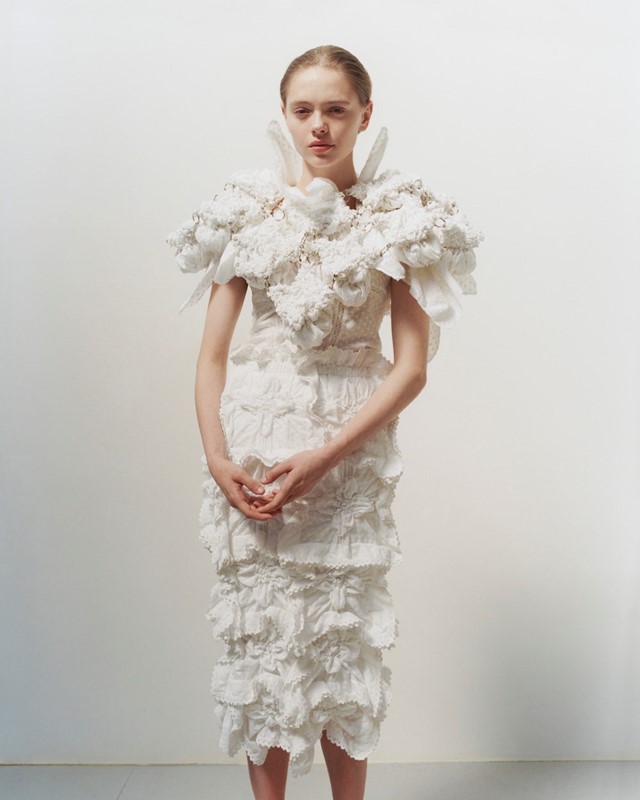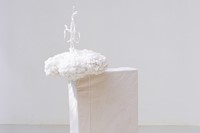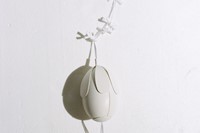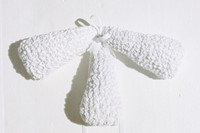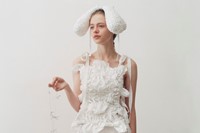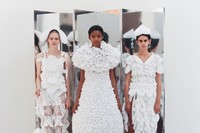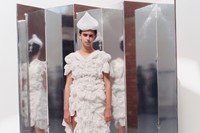“Irishness will always be a part of the label, if it’s from the craft or concept,” says the Dublin-based designer and Hyères Prize-winner, who will return to the festival this weekend to show her latest collection
- Who is it? Dublin-based designer Róisín Pierce, whose new collection will be revealed at the 35th Hyères Festival this weekend
- Why do I want it? Intricate, artisanal womenswear which draws on the stories and centuries-old craft of her native Ireland
- Where can I get it? Pierce’s pieces are available on a made-to-order basis from the designer’s website
Who is it? “As a child I was always making up dream worlds and playing,” says designer Róisín Pierce of her upbringing in rural Galway, Ireland. This active imagination – and penchant for making clothes for her Barbie dolls – lead the designer to pursue a BA in Textile Design at Dublin’s National College of Art and Design. It was there that Pierce honed her mastery of texture and fabric development, which underpin the distinctive look and ethos of her namesake label. “That programme really played into what I’m doing today ... [it’s] very textured, experimental; it’s about developing things and challenging what textiles can be in clothing,” she says. Her frothy, sculptural confections – reminiscent of whipped cream peaks, or buttercream icing flowers – won the designer the Public Prize at the 34th Hyères Festival, and the first-ever Prix Métiers d’Art Chanel.
Beneath the sweetness however, Pierce’s pieces are steeped in Irish heritage and history. Her debut collection, Mná ì bhláth – Gaelic for ‘Women in Bloom’ – was inspired by the women of Ireland’s infamous Magdalene Laundries, a series of church-run forced-labour institutions for the country’s ‘fallen women’. Pierce’s research into the subject proved timely: “Around the time I was creating Mná ì bhláth, Repeal the 8th was happening,” explains Pierce, referencing Ireland’s 2018 referendum on abortion. “I just felt a little let down by the country; women’s rights weren’t at the right level for the 21st century. I really felt like that was why I was making that collection.” In creating Mná ì bhláth, and bringing it abroad – say, to Hyères – Pierce hopes to bring awareness to political issues, past and present, in her native Ireland. It’s also a means of shining a light on the nation’s rich history of craftsmanship and, specifically, honouring the intricate craftwork of the women of the laundries. “Of course the laundries were for cleaning garments. But many people don’t know about the ‘making’ side, the crochet lace, needlepoint, and smocking,” Pierce explains.
The many-layered topic also serves as inspiration for the designer’s Chanel-supported sophomore collection, Bláthanna Fiáin (Gaelic for ‘wildflowers’), which will premiere this week at the 35th Hyères Festival via a series of photographs, film and accompanying book, a collaboration with photographer Andrew Nuding, AnOther’s fashion director Ellie Grace Cumming and art director Simon B Mørch. “This season focuses on the unwed mothers who were sent to the laundries,” explains Pierce. “The title comes from the name the Catholic church gave these women who had children out of wedlock: ‘wildflowers’. They were often wrongly perceived as promiscuous, despite the context in which they may have become pregnant.” Exploring the concept of marriage, of brides, Pierce drew upon wedding dresses and religious garments – communion dresses, even priests’ vestments. “I wanted to bring in more fabrics that were associated with brides: tulles and organzas. Working in these sheer fabrics with last season’s broderie anglaise cotton, blending them because I didn’t want to make completely transparent fabrics.” The resulting garments embody the dualities inherent to the subject matter: between modest and immodest, “innocent and not-so-innocent”, says Pierce. Sweet cotton skirts reveal subtle flashes of skin through sheer slits that open and close as the wearer walks.
“Irishness will always be a part of the label, if it’s from the craft or concept,” continues Pierce. While the designer handcrafts each of her pieces, start-to-finish, in her Dublin-based home studio, she hopes to collaborate with more Irish craftspeople and brands to continue to celebrate the country’s craft heritage. So far, the future looks promising: “For my next project, I’ll be working with very talented Irish lacemakers. I want to develop the crochet lace, to see how it can be done in a new way. That’s something I’m quite excited about and, obviously, it’s very much about Ireland. I find it inspiring, naturally, because it’s deep-rooted in me.”

Why do I want it? Pierce’s intricate garments are veritable confections: elaborate smocking that resembles perfectly piped icing, “a fresh flower” or “almost a bag that shouldn’t be a bag: a Fabergé bag”, says Pierce with a laugh, describing two pieces from her upcoming S/S21 collection. Beyond that, each Róisín Pierce garment is a show of meticulous craftsmanship. Pierce handcrafts each piece, from start to finish, developing and creating textiles, hand-smocking, patchworking, hand-embroidering, and more, all in her Dublin-based home studio. “In the fabric, I like to create textures that have three-dimensional effects,” she says. In fact, Pierce’s use of an all-white palette is to highlight the intricacies of each garment. “I only work in white,” she says. “It’s for surface. I wear all black myself ... I feel like it’s really lost in the black. Black doesn’t honour the work that goes into the textiles, fully. I feel like white is the way to show all the detail.” Some of Pierce’s more detailed pieces can take up to three weeks to create. “Even when it’s a piece that’s very time-consuming, I want the surface to completely envelop the body, to create a more interesting silhouette from all angles.”
Pierce is also committed to sustainability, keeping her studio zero-waste. “It’s become a lot of what the work is today. A lot of the pieces are made from strips and squares. Some are from scraps, the leftover pieces that were cut awkwardly and turned into something new,” she explains. Keeping her designs waste-free has been challenging, albeit rewarding for the young designer, and has even lead to some innovations in itself. “It’s nice to feel like it’s also pushing the work further because, of course, squares don’t want to turn into a garment or rest on the body. It’s a bit challenging. But I feel like it pushes the work further, which is something I’m always striving for. I really like to embrace and continue to work on it.”
Where can I get it? Pierce’s pieces are available on a made-to-order basis from the designer’s website.
